Graphics in Denmark — A Universal Language
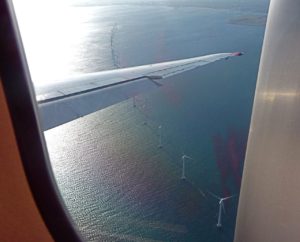 I was in Copenhagen last week after VizThink, training our partner Strandgaard & Co in graphic facilitation. I was struck by how universal a language graphics has become. The fact that I don’t speak Danish meant that I was thrown back on these visual cues to make sense of what I was experiencing.
I was in Copenhagen last week after VizThink, training our partner Strandgaard & Co in graphic facilitation. I was struck by how universal a language graphics has become. The fact that I don’t speak Danish meant that I was thrown back on these visual cues to make sense of what I was experiencing.
My sense of this began as we flew in over Copenhagen and I saw the long line of wind machines in the harbor. How quickly these have become icons of change!
I was able to spend a weekend exploring the old city. Here again, the ubiquitous bicycles spoke of a different culture in relation to energy. “Do people ride these in the winter?” I asked Vagn Strandgaard. “All year,” he said.
I took this picture from a little café in Christianshaven, across the harbor from Copenhagen. It’s a bit of the city that isn’t governed by any formal district. But even here the tidy historic housing and general order spoke of a culture that respects its traditions.
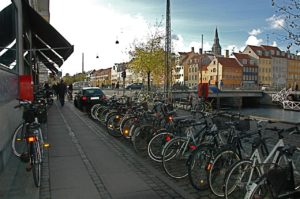
Copenhagen itself wasn’t bombed during the war, so it has a completely different, almost medieval feeling compared to Berlin. Many of the buildings are from the 1500s. This one is the original “stock market” where livestock was brought in from the ships and traded. Since my travels were accompanied by relentless reporting about the crashing of our contemporary “stock markets” I was reminded of how abstracted and symbolic so much of our work and life has become in the developed world.
Since my travels were accompanied by relentless reporting about the crashing of our contemporary “stock markets” I was reminded of how abstracted and symbolic so much of our work and life has become in the developed world.
Here I did not get a sense of the “meltdown” being as big an issue as it is for us in the states. While Denmark is not socialist in a traditional sense, government, business and public sector activities seem more balanced. Denmark is a trading nation, and very entrepreneurial. Their investments in the growing clean energy sector have been impressive.
Vagn Strandgaard’s involvement with some new innovation centers being created by Allborg University were also inspiring. Somehow having one foot in traditions has not seemed to slow the Danish march into the future.
In the center of town the reflection of this double interest again expressed itself in the visual environment. Here in the midst of a beautifully maintained historic city are giant graphics and billboards promoting electronics and other current fashions.

I was staying in a waterfront hotel called The Strand, two buildings away from Strandgaard’s Copenhagen office. Right outside was a wonderful graffiti that put it all together for me—sea, sails, the octopus of creative culture playing a guitar!

A final impression stayed with me as Vagn was driving me around the city center in the evening after dinner one night. We passed Copenhagen Corner, a shopping complex advertising with a wall of logos. I’ve seen these kinds of arrays in many cities, but it spoke to me here of how much we rely on these kinds of brands and “tags” to navigate our way through our contemporary commercial culture.
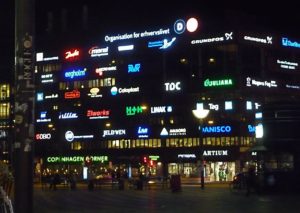
Teaching Graphic Facilitation
My workshop with Strandgaard Co. was out west of Copenhagen in Soro, a rural village close to Vagn Strandgaard’s home. We had the training in a conference center there, reflecting the wonderful grace of Scandinavian design. In addition to the Strandgaard consultants, we had several people from T-Mobile Systems in Germany, and some independent consultants from the UK and from Sweden. I love the richness of Europeans, thrown against each other like they are, almost always multi-lingual in the consulting industry, and how universal the graphics are.
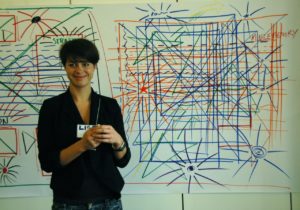 Lise Wollsen and Louise Fugesang came over from Berlin. They are with Framework Identity, the branding company that is part of the Strandgaard Group.
Lise Wollsen and Louise Fugesang came over from Berlin. They are with Framework Identity, the branding company that is part of the Strandgaard Group.
You can tell from Lise’s face how exciting is was for her to participate in the “Your Body Knows Graphic Language” exercise that is at the core of the Graphic Facilitation training. We’ve discovered at The Grove that the root of graphic meaning is in the gestural language our bodies use to communicate, and that learning graphics through the large gestural movements on the wall is a direct way to access this built-in language. This may also explain why graphic language is so universal.
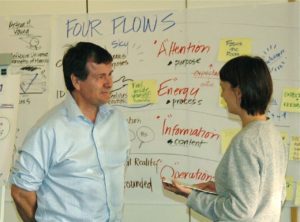 Here is a picture of Vagn Strandgaard, the founder of Strandgaard & Co., graduating from the workshop by Johanna Nordstrom, an independent consultant from Sweden fresh from studying with Maturana in Chile. Vagn’s company has been representing The Grove in Denmark for more than six years, has translated our Team Leader Guide, Team Performance Model and other Leader Guides into Danish, and is the main distributor of our materials and tools inside Danish companies, which in many cases are multi-nationals. He is deeply involved in innovation work, executive development, strategy, and group communications. He’s quite knowledgeable about all the different kinds of concepts and frameworks available for this kind of work, and is convinced that the Team Performance Model, with its underlying Process Theory, is the most useful and comprehensive that he has found. It really is the kind of framework that can be an operating system for an entire organization—any making that happen within his Danish clients is his aim.
Here is a picture of Vagn Strandgaard, the founder of Strandgaard & Co., graduating from the workshop by Johanna Nordstrom, an independent consultant from Sweden fresh from studying with Maturana in Chile. Vagn’s company has been representing The Grove in Denmark for more than six years, has translated our Team Leader Guide, Team Performance Model and other Leader Guides into Danish, and is the main distributor of our materials and tools inside Danish companies, which in many cases are multi-nationals. He is deeply involved in innovation work, executive development, strategy, and group communications. He’s quite knowledgeable about all the different kinds of concepts and frameworks available for this kind of work, and is convinced that the Team Performance Model, with its underlying Process Theory, is the most useful and comprehensive that he has found. It really is the kind of framework that can be an operating system for an entire organization—any making that happen within his Danish clients is his aim.
I left Copenhagen with the warm feeling of knowing that the network of people who are able to work visually and collaboratively is getting stronger and stronger in Europe, and that even more people are becoming acquainted with process thinking. These happy graduates are joining what is becoming a wonderful worldwide community of practice, sharing the universal language of graphics!
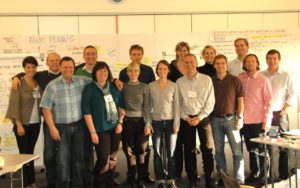


No Comments